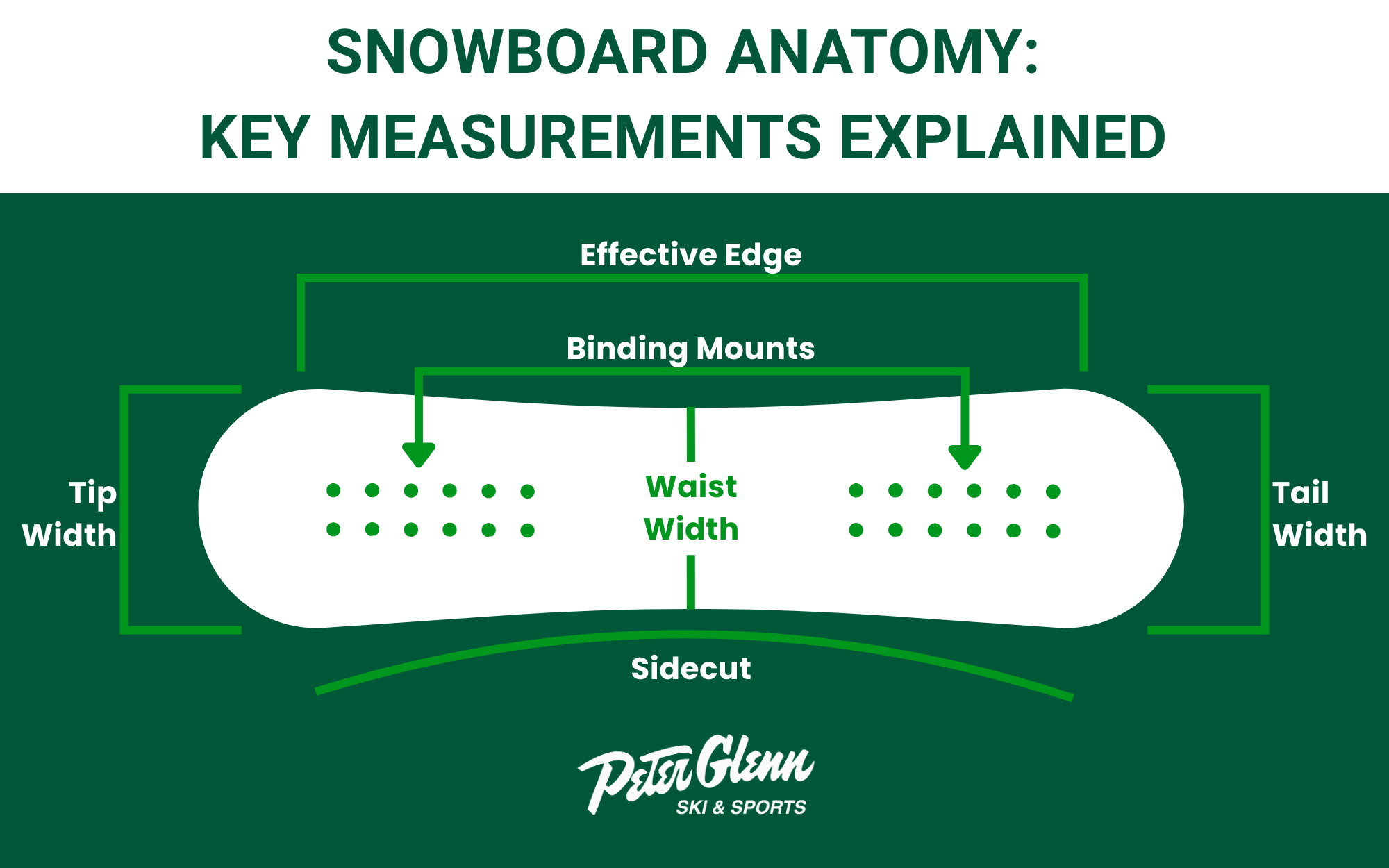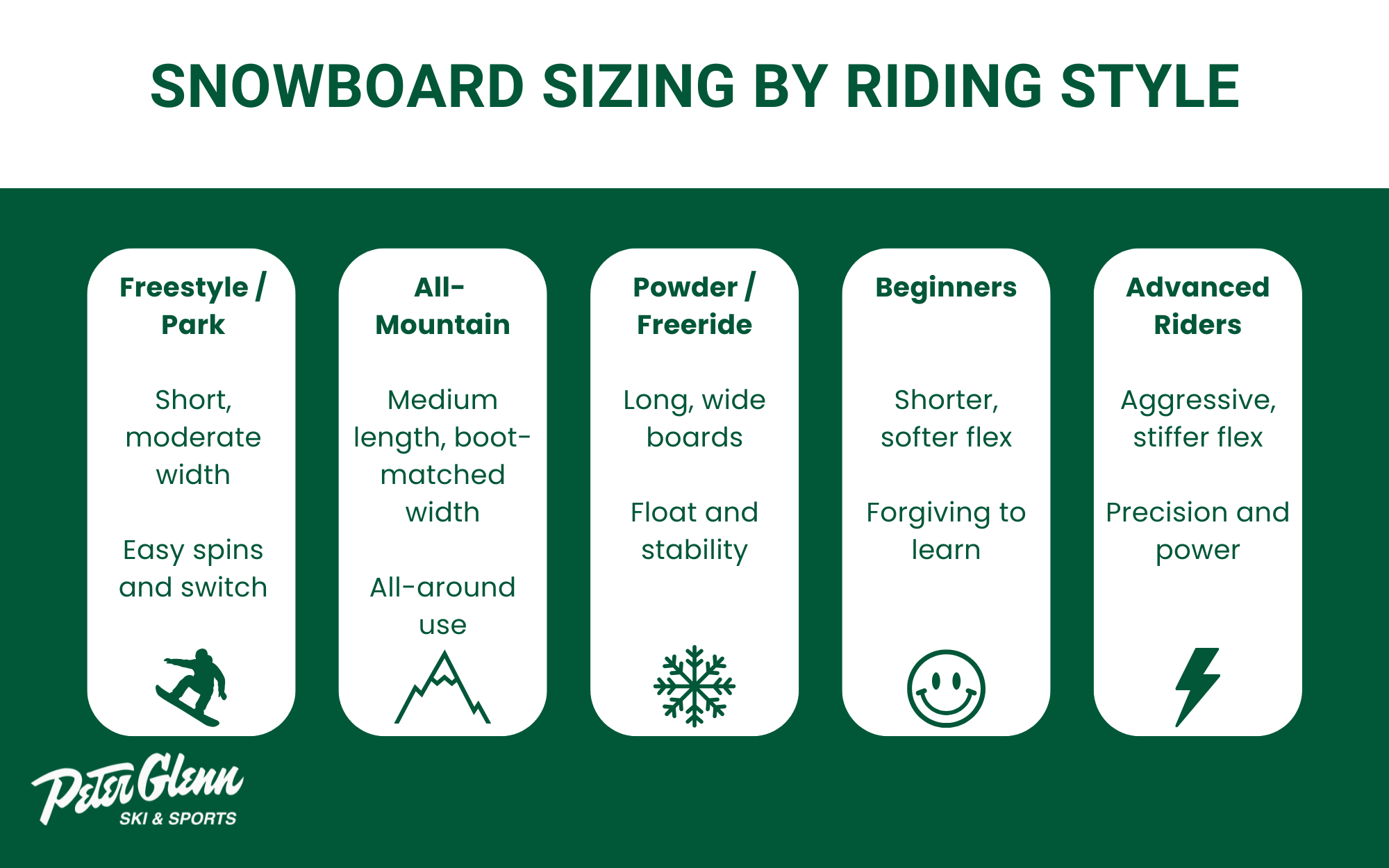How to Measure a Snowboard
Posted by Peter Glenn Staff on Sep 22nd 2025
Table of Contents:
The Short Answer: Snowboard measurements include length, width, and other key dimensions that directly affect your control, stability, and overall performance on the mountain. The right size ensures better balance, safer riding, and significantly more fun during your snow day adventures.
The wrong snowboard size can throw off your balance, limit your control, and even make riding less fun. Getting the right length and width means smoother turns, better stability, and more confidence on every run.
Understanding Snowboard Measurements
Before breaking out the measuring tape, it's important to understand what each measurement means and how it affects your ride:
Length
Measured from tip to tail, length affects your snowboard’s stability and maneuverability. This measurement is your starting point when choosing the right snowboard size.
Waist Width
The waist width is the narrowest part of the board, located under your boots. It’s critical for matching your snowboard boot size and preventing toe or heel drag.
Tip & Tail Width
These are the wider ends of the board. They influence float in powder and turning characteristics, making them especially important for different riding styles.
Effective Edge
This is the portion of the edge that contacts the snow while turning. A longer effective edge delivers more grip and stability, while a shorter one makes the board more maneuverable.
Sidecut Radius
This determines how your turns feel. A smaller radius allows quick, tight turns, which are great for the terrain park, while a larger radius supports faster, sweeping turns on groomed runs.
Flex Ratings
Though not a measurement, flex plays a big role in ride quality. Softer flex boards are forgiving for beginners and freestyle riders, while stiffer boards give better response at higher speeds.

How to Measure Snowboard Length
The classic "height test" suggests choosing a board that reaches between your chin and nose when standing upright. While this provides a helpful starting point, your weight is equally important in determining the correct size.
Your body weight affects how the board flexes and responds. Heavier riders typically need longer boards for adequate support, while lighter riders can often go shorter without sacrificing performance. Different brands may have slight variations in their sizing recommendations, so always consult the specific size chart for your chosen board.
Adjusting Length for Riding Style
- Shorter boards (chin height or below) offer increased maneuverability and playful characteristics, making them ideal for freestyle riding and terrain park sessions
- Longer boards (nose height or above) provide enhanced stability at speed and superior float in deep powder conditions
Example Sizing Ranges
- Freestyle/Park riders: -3 to -8cm from height
- All-mountain riders: -5 to +5cm from height
- Powder/Freeride riders: +5 to +15cm from height
Remember that personal preference plays a significant role. Some riders prefer the quick response of a smaller board, while others prioritize the stability of a longer board for their mountain adventures.
How to Measure Snowboard Width
Width measurement focuses primarily on your boot size. Proper snowboard boot fit requires minimal boot overhang to prevent toe and heel drag, which can catch in the snow and cause dangerous falls.
Waist Width Guidelines by Boot Size (Men’s)
- Size 6-8 boots: 240-245mm waist width
- Size 8-9.5 boots: 245-250mm waist width
- Size 9.5-10.5 boots: 250-255mm waist width
- Size 10.5-12 boots: 255-265mm waist width
- Size 12+ boots: 265mm+ waist width (wide snowboard)
Waist Width Guidelines by Boot Size (Women’s)
- Size <6 boots: <235mm waist width
- Size 6-7.5 boots: 235-240mm waist width
- Size 7.5-8.5 boots: 240-245mm waist width
- Size 8.5+ boots: 245mm+ waist width
For riders with a wide foot, even within standard shoe sizes, consider a wide snowboard to ensure comfortable boot fit and proper edge control.
Rules for Avoiding Toe and Heel Drag
- Your boot should overhang the edge by no more than 1-2 centimeters
- Check both toe and heel clearance
- Consider your stance angle - more angled stances reduce effective overhang
Tip and tail width measurements relate directly to stability and float. Wider tips and tails provide better performance in powder and improve stability during landing, making them particularly beneficial for freeride and all-mountain riding.
Other Key Measurements
Effective Edge
Effective edge length determines your grip and stability in icy conditions. Longer effective edges provide more contact with the snow, improving edge hold and control. This measurement becomes particularly important for riders who frequent groomed runs or icy conditions common at many mountain resorts.
Sidecut Radius
Sidecut radius dramatically affects your turning experience. Smaller radius measurements (typically 6-8 meters) create quick, responsive turns perfect for navigating tight terrain park features or mogul runs. Larger radius measurements (9+ meters) facilitate faster, more stable turns ideal for carving long groomers or high-speed riding.
Tip and Tail Shape
Tip and tail shape variations include rocker, camber, and hybrid profiles. These shapes influence how the board interacts with different snow conditions:
- Traditional camber provides precise edge control and pop
- Rocker profiles offer easier turn initiation and better float
- Hybrid combinations balance performance characteristics
Understanding these measurements helps you make informed decisions about which board will best match your riding style and preferred terrain.
Matching Board Measurements to Riding Style

Freestyle/Park Riding
Freestyle and park riding calls for shorter length boards with moderate waist widths. These dimensions make the board easier to spin, maneuver around terrain park features, and land tricks. The reduced length also makes the riding switch more comfortable during your progression.
All-Mountain Riding
All-mountain riding requires balanced measurements that perform well across varied terrain. Medium-length boards with appropriate waist width for your boot size provide versatility for everything from groomed runs to powder days.
Powder/Freeride Riding
Powder and freeride riding benefits from longer boards with wider waist measurements. The increased surface area provides better float in deep snow, while the added length offers stability at higher speeds typical of backcountry riding.
Beginner Considerations
Beginner considerations should prioritize forgiveness and ease of learning. Slightly shorter boards with softer flex ratings help new riders develop proper technique without fighting an overly demanding board.
Advanced Riders
Advanced riders can handle more specific sizing based on their preferred riding style and terrain. Experienced riders often choose more aggressive dimensions that match their skill level and performance expectations.
Common Mistakes to Avoid
Relying Only on Height
Many riders make the mistake of relying solely on height without considering weight or snowboard boot size. This approach often results in improper sizing that affects performance and safety.
Choosing the Wrong Width
Choosing a board that's too wide makes edge-to-edge transitions slower and more difficult, particularly problematic for smaller riders or those with narrower boots. Conversely, selecting a board that's too narrow leads to toe drag and potential crashes.
Ignoring Riding Style
Ignoring your riding style and terrain preferences is another frequent error. A board perfectly sized for park riding may feel unstable at high speeds, while a powder-specific board might feel sluggish on groomed runs.
Forgetting About Bindings
Don't forget that your binding setup and stance angle affect the overall fit. Even a properly sized board can feel wrong with incorrect binding positioning or inappropriate stance width for your body proportions.
Quick Measuring Guide
Step 1: Check Your Measurements
Determine your accurate height and weight measurements. Use these as your baseline for size chart comparisons.
Step 2: Compare to Snowboard Length Range
Consult the size chart for your chosen board, comparing your measurements to the manufacturer's recommendations. Different brands, such as Burton, Never Summer, and Salomon, may have slight variations in their sizing philosophy, so it’s always best to consult the specific size chart for the board you’re considering.
Step 3: Match Waist Width to Boot Size
Match the waist width to your snowboard boot size, ensuring minimal overhang while maintaining proper edge control.
Step 4: Adjust for Riding Style
Adjust your selection based on your primary riding style and preferred terrain. Consider whether you prioritize maneuverability or stability for your typical mountain experiences.
Step 5: Get Expert Advice
When possible, consult with knowledgeable staff at your local shop who can provide personalized recommendations based on your specific needs and local mountain conditions.
Finding Your Perfect Fit
Measuring a snowboard correctly involves understanding length, width, and how these dimensions interact with your riding style. The right measurements improve your control, comfort, and confidence on the mountain, making every snow day more enjoyable.
A properly sized board serves as the foundation for your entire snowboarding experience. Whether you're progressing through your first season or refining your technique as an advanced rider, the correct measurements ensure your equipment supports rather than hinders your development.
Ready to find your perfect snowboard? Explore our comprehensive size charts and shop snowboards from leading brands at Peter Glenn. With over 65 years of experience outfitting winter sports enthusiasts, our expert team can help you find the ideal board for your next mountain adventure.



